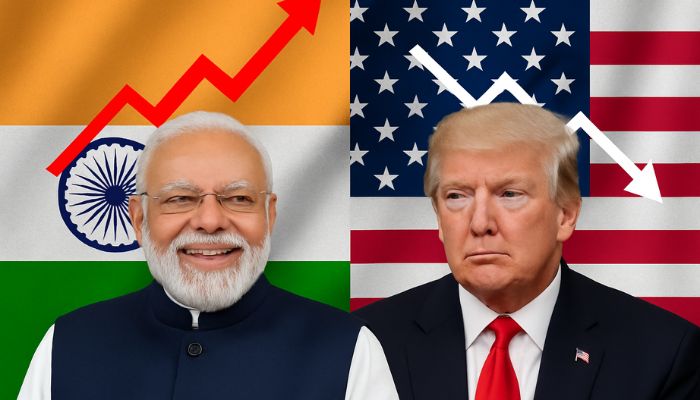The 25% tariff on Indian goods announced by US President Donald Trump might end up doing more damage to the American economy than to India’s, as per a research report [pdf] published by the State Bank of India (SBI) on Friday, 1st August.
These tariffs are expected to take effect from 7th August. Trump has also announced penalty for the purchase of Russian crude oil and military equipment, but this has not been specified in any official communication so far.
SBI Research has called the move a “bad business decision” and warns that the economic consequences could be severe for the United States. The report highlights that the new tariff policy may lead to a drop in the US GDP, rising inflation, and a weaker dollar.
Inflation in the US is already on the rise and, according to the report, could remain above the Federal Reserve’s target of 2% until at least 2026.
One of the most striking observations is the financial burden that these tariffs will place on American households. Families in the US could see their spending rise by a median of about $2,400 over the short term. Low-income families are projected to be affected by this for about $1,300, whereas more affluent families might have to pay an extra $5,000.

Even if wealthier families are more likely to absorb these expenses, the overall economic burden is likely to be shared across income levels.
India has already diversified its export base: SBI report
Despite the US being India’s largest export destination accounting for nearly 20% of India’s total exports, India may not be as badly affected as some expect.
Most of the Asian countries face higher tariff rates compared to India at present. For instance, China currently faces a post-negotiation tariff of 42%, one of the highest in the region, despite accounting for 13.4% of US imports. Bangladesh, another key trading partner, faces a 35% tariff, even though it only contributes 0.3% to US imports.

SBI report says that India has already diversified its export base. The top 10 countries combined make up only 53% of India’s total exports, giving Indian businesses some room to shift focus.
According to the SBI report, India’s GDP may take a minor hit of about 25 to 30 basis points (bps) in FY26 due to the tariffs.
Key sectors in trouble
The sectors that could feel the most heat are electronics, pharmaceuticals, and gems and jewellery. These industries make up nearly half of India’s exports to the US.
Earlier, many of these products had very low or even zero tariffs. Now, with the 25% duty, the competitive edge of Indian goods could be reduced significantly.
Pharmaceuticals, in particular, could see major disruptions. India presently provides almost 47% of generic medicines utilized in the US. If the US plans to relocate its manufacturing or active pharmaceutical ingredient (API) production elsewhere, it would take between 3 and 5 years to establish new supply chains.
Meanwhile, the US may experience shortages of the most critical drugs, triggering price increases, particularly for the most important drugs such as antibiotics, cancer medications, and medications for chronic diseases.
This change could also hit Indian pharma companies hard. The US market contributes about 40% of India’s pharmaceutical exports. If 25% tariff continues, it may hit earnings of pharma companies by 2-8% in FY26, as many big pharma companies’ revenue from US stood in the range of 40-50%.
Trade surplus and strategic buffer
India’s trade surplus with the US has increased manifold over time, from $11 billion in FY13 to an estimated $43 billion in FY25. India’s trade surplus with the US alone reached $12.7 billion in the first quarter of FY25, driven by a 22.3% increase in exports as against a modest 11.7% expansion in imports.
This increase in exports, presumably carried out in anticipation of the fresh tariffs, provides Indian firms with a temporary cushion. Exporters may take recourse to this buffer to weather the initial shock and look for new markets or tweak price strategies.
American consumers to suffer most
While the impact on India may be manageable, US consumers are expected to bear the brunt. A research by The Budget Lab at Yale University says that the average effective tariff rate for US consumers will rise to 18.3%, the highest since 1934.
American households could see clothing prices jump by 38% and footwear prices by 40% in the short term. In the long term, these prices might remain elevated, and the costs of footwear and apparel might be 19% and 17% higher, respectively.
This may mostly affect middle- and low-income Americans who depend on cheap imports for regular necessities.
Berkshire Hathaway’s warning
Even large US companies are starting to feel the pain. Warren Buffett’s Berkshire Hathaway just had a 5.1% decline in second-quarter revenue from its consumer goods operations. The firm attributed the decline in revenue to reduced volumes, delayed shipments, and the effects of tariffs.
Berkshire holds such iconic brands as Fruit of the Loom and Jazwares, and stated that Trump’s trade policies have damaged business. Buffett, a strong free-trade advocate, previously cautioned that tariffs should not be used as a “weapon,” with balanced trade being in everyone’s best interest.
Despite these challenges, not all parts of Berkshire’s business were affected. For instance, shoe brand Brooks saw an 18.4% rise in revenue, showing that some niches may still manage to grow despite the broader headwinds.
Conclusion
In the end, Trump’s tariff decision may end up being a case of self-harm for the US economy. While India will face some immediate challenges, its diversified exports and strong global pharma role provide a buffer. On the other hand, the US is looking at higher prices, potential drug shortages, and a squeeze on consumer wallets, all of which could make these tariffs costlier than they seem on paper.

